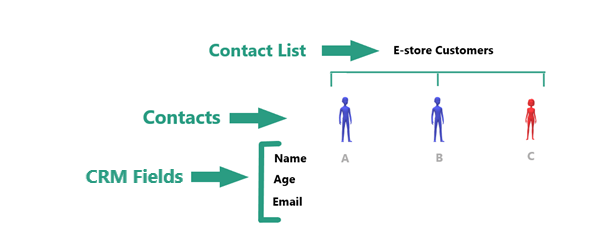1. Contacts
All information pertaining to a customer is saved under the entity contact in the MainBrainer CRM. A contact captures complete information available for a customer – name, dob, mobile number, Email address, opt-in status, etc., under different fields in the CRM.

2. List
To structure and organize your contacts database, you can create groups of contacts called Lists. You can group contacts on the basis of criteria that suit your marketing strategies or business preferences.
For example, you can create and maintain separate lists for:
- your e-store customers
- customers who shop from your brick-and-mortar store
- customers who signed up from your social media profiles, etc.
For your convenience, when you create a new list, make sure that you give your list and identifiable name, and you are good to go!
Note that a list is static in nature, i.e., once the contacts are added to a list, they will remain in the list unless you manually remove them or add any more contacts to the list.
3. Segments
A Segment is a sub-group within a contact list based on certain conditions or criteria.
Segments can help you in targeting the right customers and improve your conversion rates.
For example, a Fashion retailer might want to target customers based on their age and/or gender. The fashion choices of a college-going girl tend to be diametrically different from a 40-year-old man. It makes sense to pitch them different products, right?
Segments help you create such specific groups within your contact lists. You can incorporate one or multiple conditions to create relevant customer segments.

Segments can be static sub-groups or dynamically updating sub-groups based on the segment type chosen at the time of segment creation.
